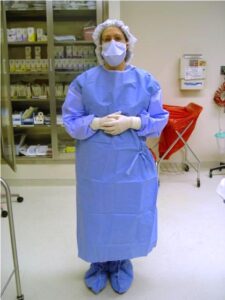1-1. GENERAL

a. Discussion. All members of the sterile team are required to perform a surgical hand scrub and don sterile gown and gloves before touching sterile equipment or the sterile field. The correct performance of these procedures helps protect a patient from infection by preventing pathogenic (disease-producing) microorganisms on the hands, arms, and scrub clothes of “sterile” team members from coming into contact with a patient’s wound during an operation. Infection that may result from the introduction of pathogenic microorganisms into a wound could prove fatal to the patient.
(1) The surgical scrub is a systematic washing and scrubbing of the hands and forearms using especially developed techniques and the most effective antibacterial cleaning agent available for such use. This procedure is done to render the hands and arms as free as possible from microorganisms. The skin cannot be sterilized without destruction of tissue, but as many bacteria as possible can be removed by a thorough hand and arm scrub, making the skin surgically clean.
(2) Gown and glove procedures, which are performed following the surgical scrub, involve the donning of sterile surgical gowns and gloves in such a way as to maintain the sterility of the outside of both gown and gloves.
b. Purpose of the Procedures. Scrub, gown, and glove procedures are performed to eliminate some of the controllable sources of contamination in the performance of aseptic procedures. The operating room specialist assigned to scrub for an operation should adhere absolutely to the exacting techniques. The specialist must scrub his hands and arms for a prescribed length of time or for a prescribed number of brush-strokes. Such techniques will keep the patient as free from microorganisms as possible. The scrub dons sterile gown and gloves to provide a sterile covering for his clothing and hands.
c. Handwashing By the Circulating Specialist (Circulator). Although the circulator is not required to perform a surgical scrub, he should wash his hands thoroughly between tasks for his own protection and for that of the patient. Handwashing is an important factor in preventing the spread of disease. Nowhere is this procedure more important than in the operating room where the body defenses of the patient are weakened both by the disorder that makes his surgery necessary and by the surgery itself.
d. Microorganisms Normally Present. The microorganisms normally present on the skin can be classified as transient and resident.
(1) Transient organisms are those microorganisms that are introduced onto the skin surface by contact with the soil and various other substances. Mechanical scrubbing and surgical soaps will remove most of the bacteria.
(2) Resident organisms are those microorganisms whose natural habitat is the skin. They are comprised mostly of gram-positive and gram-negative bacteria. They exist in large numbers under the fingernails and in the deeper layers of the skin (such as the hair follicles, the sweat glands, the sebaceous glands). Scrubbing removes the resident bacteria from the surface and just beneath the surface of the skin. After a time, the resident organisms in the deeper layers of the skin are brought to the surface by perspiration and the oil secretion of the sebaceous glands and the bacterial count is again increased. For this reason, sterile gloves are worn to prevent contamination of the patient’s wound and the sterile goods used in it by organisms from this source.
e. Local Policy. The local policy (Standing Operating Procedure (SOP)) is the final authority on the method employed for scrubbing the hands and arms and for the type of surgical detergents to be used; policies vary among hospitals.
1-2. PURPOSE AND SCOPE OF THE SUBCOURSE
a. This subcourse sets forth effective procedures and techniques for scrubbing, gowning, and gloving. In the absence of local policy, the specialist should employ these procedures.
b. To obtain maximum benefit from the ensuing instruction, all procedures should be practiced.
